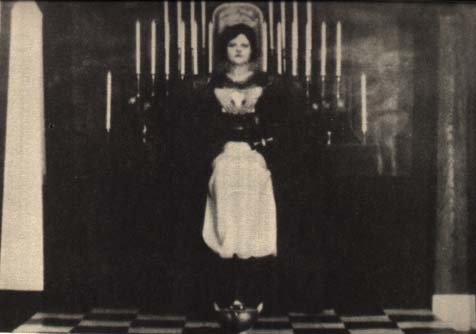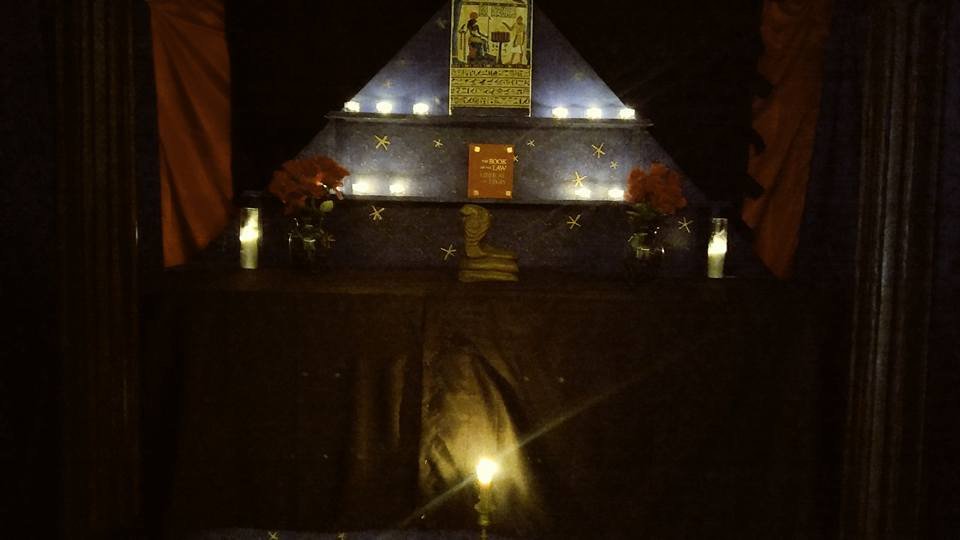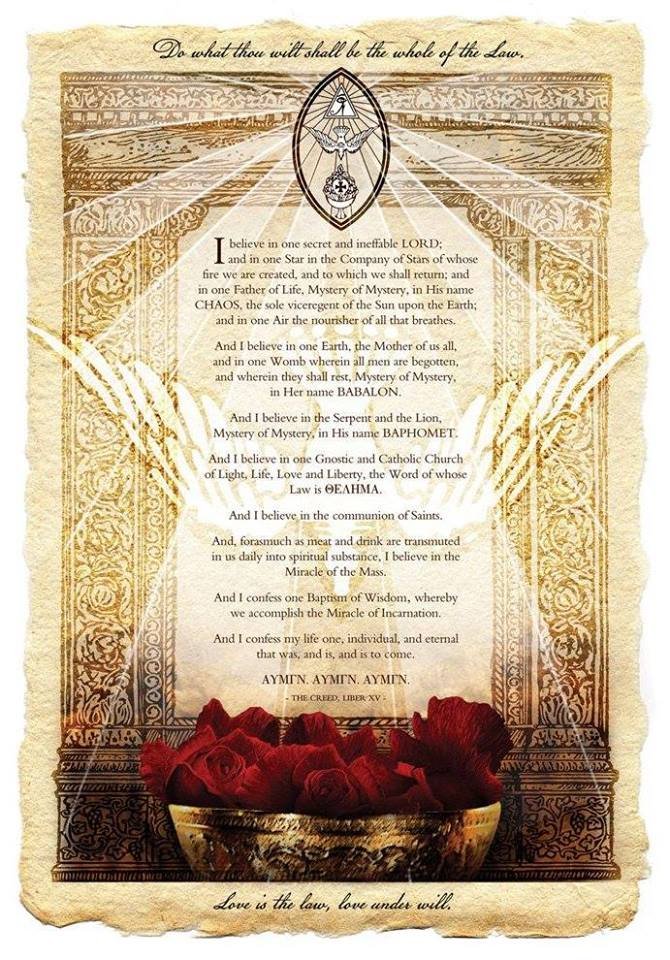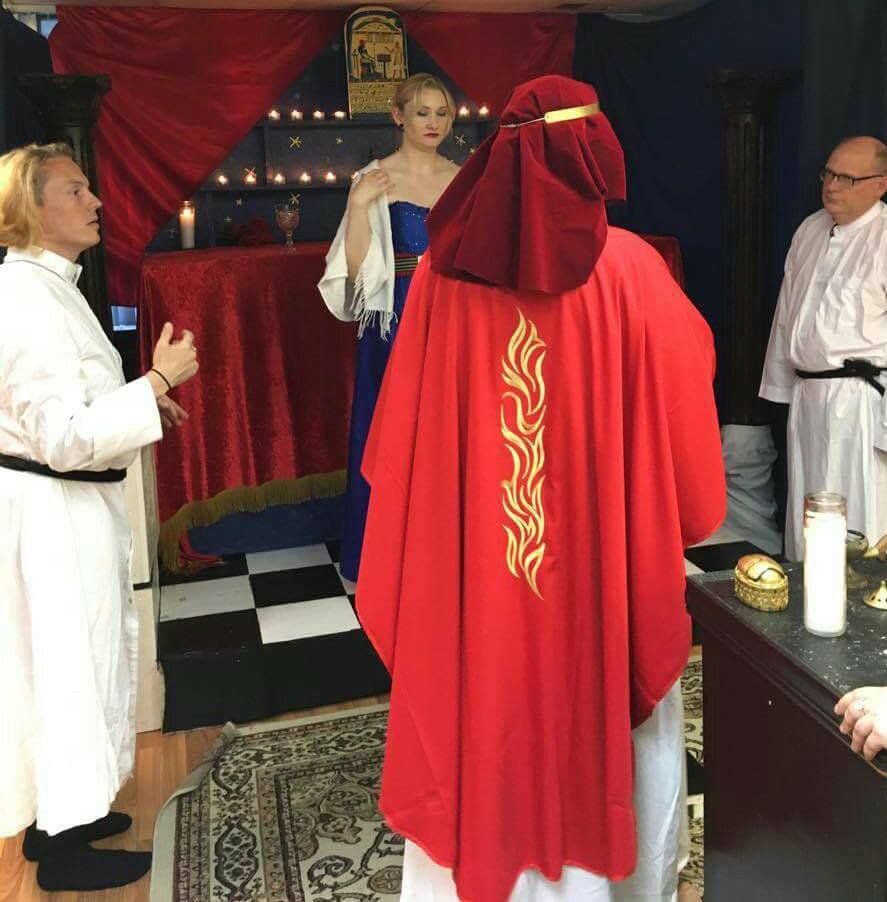Do what thou wilt shall be the whole of the Law.
Ecclesia Gnostica Catholica
Ecclesia Gnostica Catholica (E.G.C.), or the Gnostic Catholic Church, is the ecclesiastical arm of Ordo Templi Orientis (O.T.O.). The E.G.C. is a Thelemic religious environment, dedicated to the advancement of Light, Life, Love, and Liberty through alignment with the Law of Thelema.
The central activity of the E.G.C. is the celebration of the Gnostic Mass, as set forth in Liber XV, written by Aleister Crowley for O.T.O. and E.G.C. in 1913. Lay membership in E.G.C. is available through baptism and confirmation. Members of O.T.O. in good standing are eligible for clerical ordination in E.G.C. Members of II° and higher are eligible for ordination as Deacon, and those who have reached K.E.W. are eligible for ordination as Priest or Priestess. Many O.T.O. local bodies celebrate the Gnostic Mass on a regular basis. In most locations, no formal affiliation is required to attend the Mass.
History of E.G.C.
The Gnostic Catholic Church was founded in 1907 e.v. by Jean Bricaud, Gérard Encausse and Louis-Sophrone Fugairon; the latter two having been bishops of Jules Doinel’s Gnostic Church (1890) before Doinel’s abdication as Patriarch. In 1908 e.v., Theodor Reuss appears to have received episcopal consecration and primatial authority in the Gnostic Catholic Church from Encausse, Bricaud and Fugairon in gratitude for his issuance to Encausse of a patent for the Masonic Rites of Memphis and Mizraim. The same year, Encausse, Bricaud and Fugairon changed the name of their church to the Universal Gnostic Church, leaving Reuss exclusive authority in the Gnostic Catholic Church. As with all his other affiliations, Reuss incorporated the Gnostic Catholic Church into the system of O.T.O.
Crowley adopted the Latin name Ecclesia Gnostica Catholica (E.G.C.) for use in Liber XV. Bricaud had used this name in the title of a Mass he circulated around 1908, but it was not generally used prior to Crowley’s use of it in Liber XV. Reuss translated the Gnostic Mass into German and published it in 1918 e.v., adopting it as an official rite of the Gnostic Catholic Church; and proclaiming himself “Sovereign Patriarch and Primate of the Gnostic Catholic Church,” as well as Gnostic Legate to Switzerland for Bricaud’s Universal Gnostic Church. Reuss’s publication of the Gnostic Mass constituted the formal acceptance of the Law of Thelema by the Gnostic Catholic Church, and its formal declaration of independence from Bricaud’s Universal Gnostic Church.
Ecclesia Gnostica Catholica is an inseparable part of Ordo Templi Orientis; and the Gnostic Mass is one of the official rituals, more specifically the central ritual, of Ordo Templi Orientis.
While E.G.C. traces its historic origins to the French Gnostic revival of the turn of the century, which was a movement within Christianity, it has since accepted the Law of Thelema. It has declared itself independent from the Christian Universal Gnostic Church and its successors, and is no longer considered to be a Christian Church. E.G.C. does not administer Christian Sacraments. Its ecclesiastical powers are founded on a spiritual succession from the Master Therion and the constituent originating assemblies of O.T.O., rather than on Christian Apostolic Succession.
The theology, doctrines and sacramental theory of E.G.C. are based on the principles of the Thelemic Religion. Its rites and ceremonies are eclectic in form (drawing upon the sacerdotal practices of a wide variety of cultures and historical religious systems), but are fundamentally Thelemic in character. The traditional doctrines, theology, canon law, and insignia of the Roman Catholic, Orthodox, and Jacobite Churches do not operate within E.G.C.
Membership in E.G.C.
There are two recognized subclasses of Church membership, the Clergy (Clerical membership) and the Laity (Lay membership). The Clergy is composed of the Father (or Mother) of the Church (also known as the Patriarch or Matriarch), the Primate, the Bishops, the Priests and Priestesses, and the Deacons.
The Clergy: The Patriarchate
The Father (or Mother) of the Church, also known as the Sovereign Patriarch or Sovereign Matriarch, is the O.H.O. of O.T.O. All official rites and ceremonies used within E.G.C. are subject to the approval of the Patriarch. The Patriarch has the sole authority to suspend, revoke, and reinstate the recognition of any person’s clerical status as Bishop, Priest, Priestess or Deacon within E.G.C., and any person’s Clerical or Advisory membership in E.G.C. The Patriarch has the authority to approve texts to be used in celebrations of the Gnostic Mass by Priests and Priestesses of E.G.C., modify the Gnostic Mass to suit special functions and occasions, to set guidelines for its proper performance, and to issue guidelines for the preparation of the eucharistic elements.
At this time, the Patriarch is Frater Superior Hymenaeus Beta, O.H.O. of O.T.O.
The Clergy: The Primacy
The Primate, or Presiding Bishop, is the National Grand Master General X°. The Primate shall in general supervise and control the affairs of E.G.C. within the U.S.A., subject to the ultimate authority of the Patriarch.
At this time, the Primate of E.G.C. within the U.S.A. is Sabazius X°, National Grand Master General of the U.S. Grand Lodge of O.T.O. Frater Superior Hymenaeus Beta has delegated, in full, his duties and authority within E.G.C. to Sabazius X° for exercise within the U.S.A. The actions and decisions of the Primate are subject to modification or reversal by the Patriarch upon appeal by any Bishop within the U.S.A.
The Clergy: The Episcopate
Bishops have the power and authority within E.G.C. to celebrate the Gnostic Mass; to ordain Priests, Priestesses and Deacons of E.G.C.; and to perform baptisms, confirmations, marriages and last rites, in accordance with local laws.
Bishops within E.G.C. must be Sovereign Grand Inspectors General VII° of O.T.O. Bishops of E.G.C. have the responsibility of serving as official representatives of E.G.C. within O.T.O. Any public celebration of the Gnostic Mass which involves the participation of a recognized Bishop of E.G.C. as an officer is by definition an official O.T.O. event and is subject to all the policies of O.T.O. regarding official O.T.O. events.
The term “Bishop” does not carry the same meaning within E.G.C. as it does in Christian Churches or in the so-called “Wandering Bishops” tradition. Possession of a valid and documented Apostolic Succession does not make one a Bishop of E.G.C.; neither is a Christian Apostolic Succession necessary to the Bishops of E.G.C.
Gnostic Bishops of the Doinel Succession assume a Mystic Name prefaced by the Greek letter “T” or “Tau” upon their consecration. Bishops of E.G.C. who wish to emphasize this part of their spiritual heritage may, at their option, follow this tradition. However, the Double Tau is reserved for use by the Patriarch and the Primate.
The Clergy: The Priesthood
The Priesthood of E.G.C. includes both Priests and Priestesses. Priests and Priestesses have the Sacerdotal power and authority to celebrate the Gnostic Mass as representatives of E.G.C. within O.T.O. A Bishop may also delegate to them the authority to ordain Deacons and perform baptisms, confirmations and last rites; and, in certain cases, to perform weddings. Priests and Priestesses are expected to coordinate their work with a Bishop.
Priests and Priestesses within E.G.C. must be Initiate members in good standing of at least the Knight of the East and West (KEW) degree. Their ordination must be reported to and recorded by the Grand Secretary General and the Ecclesiastical Secretary. They must be Lay members in E.G.C. prior to their ordination. The Primate may allow lay members to take on limited duties and authority of the Priesthood under the supervision of a Bishop.
Priests and Priestesses of E.G.C. have the responsibility of serving as official representatives of E.G.C. within O.T.O. Any public celebration of the Gnostic Mass which involves the participation of a recognized Priest or Priestess of E.G.C. as an officer is by definition an official O.T.O. event and is subject to all the policies of O.T.O. regarding official O.T.O. events.
The Clergy: The Deacon-Sacerdotes
The Deacon-Sacerdotes of E.G.C. are ordained Deacons of E.G.C. who are additionally recognized by the Patriarch as possessing sacerdotal powers equal to those possessed by Priests and Priestesses. For Deacon-Sacerdotes to be recognized and accorded full status as such within the Clerical membership of E.G.C., they must be Initiate members in good standing of at least the Knight of the East and West degree.
Within E.G.C., Deacon-Sacerdotes have the sacerdotal power and authority to celebrate the Gnostic Mass as representatives of E.G.C. within O.T.O., in the role of Deacon, under the supervision of a Bishop. A Bishop may also delegate to them the authority to ordain Deacons and perform baptisms, confirmations and last rites; and, in certain cases, to perform weddings. Deacon-Sacerdotes are expected to coordinate their work with a Bishop.
Deacon-Sacerdotes who are actively undergoing novitiate training for ordination to the Priesthood under the supervision of a Bishop, may serve as Priest or Priestess in a public Gnostic Mass.
Deacon-Sacerdotes of E.G.C. have the responsibility of serving as official representatives of E.G.C. within O.T.O. Any public celebration of the Gnostic Mass which involves the participation of a recognized Deacon-Sacerdote of E.G.C. as an officer is by definition an official O.T.O. event and is subject to all the policies of O.T.O. regarding official O.T.O. events.
The Assistant: The Diaconate
The Deacons of E.G.C. are ordained assistants to the Priests and Priestesses. Deacons within E.G.C. must be Initiate members in good standing of at least Second Degree (First Degree with the permission of the Primate); and their ordination must be recorded by the Grand Secretary General and the Ecclesiastical Secretary. Prior to their ordination, they must have been accorded Lay membership in E.G.C.
Deacons have the power and authority only to assist recognized Priests and Priestesses of E.G.C. in the performance of their duties. They are not considered as official representatives of E.G.C.
The Novitiate
Initiate members of any degree who have been accorded Lay membership in E.G.C. may undergo a period of Novitiate training under the supervision of a Bishop, to prepare them for ordination as Priest, Priestess or Deacon. Such Initiate members may participate in the celebration of the Gnostic Mass as Novice Priests, Priestesses and Deacons.
Novice status is not formally recognized by the Order, and is not included in the Order’s records.
The Laity
Lay Membership in E.G.C. is conferred by the ceremony of confirmation, which must be preceded by the ceremony of baptism. Lay Membership conveys no authority or special privileges within E.G.C. The Patriarch may, from time to time, modify or waive the ceremonial requirements for Lay membership in E.G.C.
Baptism is open to any person at least 11 years old. Baptism does not confer Lay Membership. Confirmation is open to any person who has been baptized and who has attained the age of puberty. Baptism or confirmation for any person less than 18 years of age requires the prior written consent of the custodial parent(s) or legal guardian(s). Baptism and confirmation are public ceremonies.
Love is the law, love under will.






